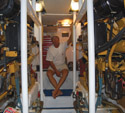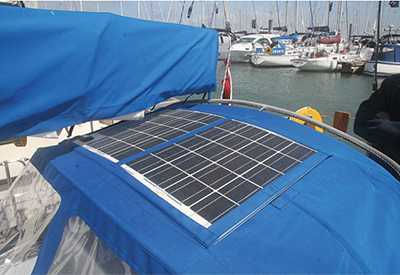Searching for the Ideal Engine Room

So, I have to open with a joke. There are two kinds of people in the world: those who divide all the other people in the world into two kinds of people, and those who don’t.
For the purposes of this article, I do!
To be more specific, I divide boaters into two kinds of people: those who want to play in the engine room and those who don’t. Whether your boat is power or sail, you are almost certain to have an engine and every engine needs maintenance and occasional repair.
Boat engines lead difficult lives. They sit there unused, cold and damp in the engine room for days, weeks, sometimes months and then we expect them to fire right up and – within a few minutes – be able to run at maximum RPM.
They’d better be able to run at maximum RPM. If they can’t take full throttle, you may not get the boat to plane off. Also, if they can’t make it up to maximum RPM, you know that something’s wrong.
Perhaps the engine isn’t getting enough air. Something may be blocking the ventilation that could heat things up and even cause a fire. An engine that won’t reach maximum RPM may have a fuel delivery problem, ignition or timing problems; another possibility is that the transmission or drive system has a problem.
A salty old master mechanic once told me that, at least for a short blast once the engine is warmed up, you should take it to maximum RPM every time you use the boat. Whether you agree or not, it’s something to think about.
If you’re the kind of person who doesn’t want to go into the engine room, that advice is particularly valuable. Instead of getting your hands dirty, your observations of how your boat is running is the best way to tell if it needs service (outside of regular maintenance intervals, of course).
If you are the other kind of person who does like to venture into the engine room, just looking around and checking for problems is a great way of avoiding problems when you’re out on the water.
You might see a coating of oil, a dusting of rubber fragments on engine parts or on the floor and you might smell oil or worse, fuel in the bilge. These are all obvious signs of trouble. Get the mechanic to check it out before you head out.
The well-rigged engine room helps you to be proactive about inspecting your engines and drives.
We have found that many new boat builders have rigged their engine rooms with clearly visible seawater strainers, brightly marked oil dipsticks, visible indicators on trim pumps for the fluid level, sight glasses for coolant levels and large glass bowls on oil filtration systems so that one can easily see if water or other contaminants are fouling the oil.
The best engine room is the one that’s easy to get to for maintenance.
However, with all the boat reviews we do at Canadian Yachting, we often think that engine room access takes a back seat to design and layout. It sometimes seems that the mechanical systems are dictated by stylists, not the engineers or the technicians who will be doing the maintenance and repair work later.
Our biggest concern is for our readers' safety should they experience mechanical problems in rough water when the engine is hot. Crawling into the engine room when the boat is rocking with winds and waves risks injury. So, let’s avoid needing to go there.
Among the top quality, popularly priced boats, we have long felt that Cruisers Yachts does a particularly good job with its engine room rigging. So, when we were at the facilities in Oconto, Wisconsin, we interviewed Jon Viestenz and Todd Trepanier while on board the new Cantius 41. Todd guided us to the finer points of that engine room and we made a short video about it. You can see that on the Canadian Yachting website at www.canadianyachting.ca.
If you are doing some new boat shopping at the shows this winter, or working with a broker to find you your dream boat, these ideas and suggestions should help you avoid an engine room nightmare.
First, look for a boat that was built to American Boat and Yacht (ABYC) standards. These are largely reflected in Transport Canada construction standards and National Marine Manufacturers Association (NMMA) standards. Ask your dealer for information.
Then, make sure battery and electrical connections and switches are accessible and clearly marked.
Next, consider how you can physically get into the engine room if a breakdown were to occur in high waves. Is there a risk of hitting your head, getting burned on a hot engine part, falling down a ladder, or losing your balance?
Is there access all around the engine(s)? You want to see all sides when checking for an oil leak. Are oil dipsticks and filter sight glasses easily checked? Can you physically reach all critical systems like hydraulic steering hoses and connections, fuel lines, and important electrical connections without crawling over a hot engine?
Could you clear a raw water strainer or shut a through hull fitting? Is there strong enough light in there to even see, let alone fix a problem?
Taking a powerful flashlight is good too; you can never have too much light in the engine room.
Hopefully, the builder has clearly marked every line and wire so you know what each one is for. If they haven't done that, work with your dealer’s mechanic to put a big label on all important parts.
Take the owner’s manual with you, or print one off (if it has not been supplied) and keep that copy handy too.
If you do have to go below in an emergency, station another person nearby and talk your way through it. Finally, don’t be afraid to call for help if you need it!
By Andy Adams





























